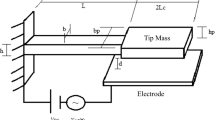Abstract
The mathematical modeling and analysis of electrostatically actuated micro- and nanoelectromechanical systems (MEMS and NEMS) has typically relied upon simplified electrostatic-field approximations to facilitate the analysis. Usually, the small aspect ratio of typical MEMS and NEMS devices is used to simplify Laplace’s equation. Terms small in this aspect ratio are ignored. Unfortunately, such an approximation is not uniformly valid in the spatial variables. Here, this approximation is revisited and a uniformly valid asymptotic theory for a general “drum shaped” electrostatically actuated device is presented. The structure of the solution set for the standard non-uniformly valid theory is reviewed and new numerical results for several domain shapes presented. The effect of retaining typically ignored terms on the solution set of the standard theory is explored
Similar content being viewed by others
References
Crowley J. (1986). Fundamentals of Applied Electrostatics. Laplacian Press, San Jose, 272 pp
Nathanson H.C., Newell W.E., Wickstrom R.A. (1967). The resonant gate transistor. IEEE Trans. on Electron Devices 14: 117–133
Bao M., Wang W. (1996). Future of microelectromechanical systems (MEMS). Sensors and Actuators A 56:135–141
Camon H., Larnaudie F., Rivoirard F., and Jammes B., Analytical simulation of a 1D single crystal electrostatic micromirror. In: Proceedings of Modeling and Simulation of Microsystems (1999)
Chu P.B., Pister K.S.J. Analysis of closed-loop control of parallel-plate electrostatic microgrippers. In: Proc. IEEE Int. Conf. Robotics and Automation (1994) pp. 820–825
Tilmans H.A.C., Elwenspoek M., Fluitman J.H.J. (1992). Micro resonant force gauges. Sensors and Actuators A 30:35–53
Anderson M.J., Hill J.A., Fortunko C.M., Dogan N.S., Moore R.D. (1995). Broadband electrostatic transducers: modeling and experiments. J. Acoust. Soc. Am. 97:262–272
Saif M.T.A., Alaca B.E., Sehitoglu H. (1999). Analytical modeling of electrostatic membrane actuator micro pumps. J. Microelectromech. Syst. 8:335–344
Pelesko J.A., and Bernstein D. (2003). Modelling MEMS and NEMS. Chapman and Hall/CRC, Boca Raton, FL, 376 pp
Zhao X.P., Abdel-Rahman E.M., Nayfeh A.H. (2004). A reduced-order model for electrically actuated microplates. J. Micromech. Microengng. 14:900–906
Bochobza-Degabi O., Elata D., Nemirovsky Y. (2002). An efficient DIPIE algorithm for CAD of electrostatically actuated MEMS devices. J. Microelectromech. Syst. 11:612–620
Pelesko J.A., Chen X.Y. (2003). Electrostatically deflected circular elastic membranes. J. Electrostat. 57:1–12
Pelesko J.A. Electrostatic field approximations and implications for MEMS devices. In: Proceedings of ESA 2001 (2001) pp. 126–137
Pelesko J.A., Bernstein D.H., McCuan J., Symmetry and symmetry breaking in electrostatic MEMS. In: Proc. of MSM 2003 (2003) pp. 304–307
Joseph D.D., and Lundgren T.S. (1973). Quasilinear Dirichlet problems driven by positive sources. Arch. Rational Mech. Anal. 49:241–269
Taylor G.I. (1968). The coalescence of closely spaced drops when they are at different electric potentials. Proc. R. Soc. London A 306:423–434
Ackerberg R.C. (1969). On a nonlinear differential equation of electrohydrodynamics. Proc. R. Soc. London A 312:129–140
Fornberg B. (1996). A Practical Guide to Pseudospectral Methods. Cambridge University Press, Cambridge, 242 pp
Trefethen L.N. (2000). Spectral Methods in MATLAB. Society for Industrial and Applied Mathematics, Philadelphia, 184 pp
McGough J.S. (1998). Numerical continuation and the Gelfand problem. Appl. Math. Comp. 89:225–239
Allgower E.L., Georg K. (2003). Introduction to Numerical Continuation Methods. Society for Industrial and Applied Mathematics, Philadelphia, 388 pp
Author information
Authors and Affiliations
Corresponding author
Rights and permissions
About this article
Cite this article
Pelesko, J.A., Driscoll, T.A. The effect of the small-aspect-ratio approximation on canonical electrostatic MEMS models. J Eng Math 53, 239–252 (2005). https://doi.org/10.1007/s10665-005-9013-2
Received:
Accepted:
Published:
Issue Date:
DOI: https://doi.org/10.1007/s10665-005-9013-2




